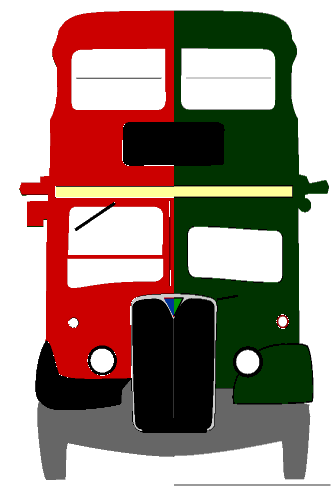
Unladen weight: 7620kg
Max cruising speed: 38mph
Provincial style Weymann design, built at Addlestone.
Passenger Capacity/ classification: L27/26R (= Lowbridge, 27 upstairs seated, 26 downstairs seated, rear entrance). Total 53 seated, max 5 standing (downstairs only).
Electrical system:
Refer to the Diagrams for dimensional information
Differences between First and Second Batches
Generally similar to the mass produced RT (Regent III) design. Built by AEC at Southall, Middlesex
Majority of threads, style: British Standard Whitworth (BSW)
Engine
AEC type A217.
Max torque 430 lb ft at 1000 rpm. Power 115 b.h.p. at 1800 rpm.
Oil Capacity: 8 Imperial Gallons or 8¾ Imperial Gallons
Maximum governed speed: under load 1800 rpm, no load 2000 rpm
Air intake filter: Oil bath, mounted on top of engine (this meant a high bonnet line was required).
Cylinders: 6. Capacity 9.6 litres. 120mm bore x 142mm stroke. Firing order 1, 5, 3, 6, 2, 4 (numbers from fan end). Compression ratio 16:1. (11.3 litre and other versions can be adapted to fit into engine bay).
Water capacity: 6.5 Imperial gallons
Starter motor: Axial
Fuel System
Diesel (aka Derv or Fuel Oil).
Tank capacity: 35/45 Imperial gallons
Lift pump: CAV DFP1 (mounted on injection pump)
Injection pump: Simms SPE6B80 or CAV BPE6B80R320 or CAV NL6E80
Fuel consumption: 9 to 12 miles per gallon (mpg)
Transmission
Fluid flywheel (no clutch).
Gearbox: pre-selective, epicyclic (Wilson), 4 speed + reverse. Ratios: 1st gear 4.50:1, 2nd gear 2.53:1, 3rd gear 1.64:1, 4th gear 1:1, Reverse 6.90:1. Air operated using the operating pedal.
Drive line: Worm differential at rear, ratio 5.17:1
Chassis
AEC model Regent 3, type 9612E (first batch RLH 1 to RLH 20) or 9613E (second batch RLH 21 to RLH 76).
Frame side members ran all the way to the back of the bus, underneath the platform entrance. This is different to the RT design where the members finished at the rear riser behind the rear wheels.
Ground clearance: 7 in (under rear axle worm casing)
Air System
Compressor belt driven from gearbox. Air intake taken from inside cab where there is an alcohol resovoir and filter (first batch) or just a felt filter (second batch).
Reservoir supplies gearbox and foot brake.
STOP flag above windscreen indicates low pressure (white light on cab ceiling also should illuminate).
Suspension
Leaf springs on both sides of both axles.
AEC's patent anti-roll stabilizer fitted behind rear axle.
Stabilizers front and rear
Wheels
Tyres: cross-ply, 9.00-20
Front axle; x2, Rim diameter 20in, Rim width 6.00in, Wheel offset 4.375in?
Rear axle; x4, Rim diameter 20in, Rim width 6.00in, Wheel offset 5.375in.
Wheelbase: 16ft 4in
Brakes
Drum brakes on all wheels.
Service (foot) brakes are air pressure operated.
Hand brake is manual, on rear wheels only. No automatic adjuster is fitted for the shoes. The foundation brake has an S cam arrangement with a 15.5 inch diameter drum, which gave considerably more clearance between it and the wheel compared to the London RT's 16.75 inch diameter. This gave 2 advantages: thicker brake liners could be used (¾ inch instead of ⅝ inch), and liner life was longer due to reduced temperature. In fact, six RTs were converted to the RLH arrangement as an experiment in the early 1950s, leading to a similar design used in the new Routemaster bus being developed.
Dynamo (generator): Mounted on side of engine, creating a bulge in the bonnet side
© Timebus 2002-2024